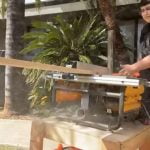Introduction
Woodworking is an enjoyable and rewarding hobby, with the potential to create amazing projects like furniture, toys, artwork and much more. Whether you do it as a profession or purely for recreation, getting started in the world of woodworking can seem daunting. It requires some knowledge regarding tools, materials and important safety practices. However, all of this is easily within reach if you start off with these basics.
The most important thing when it comes to woodworking is having the correct tools. Different types of projects require different types of tools and it is important to research and purchase ones that will be fit for your project’s purpose. Proper safety also must always be taken into consideration when using power tools such as dip saws and routers as well as handheld tools like chisels, hammers or saws. Protective gloves, face masks and ear plugs should also be worn to keep yourself safe at all times while working with wood.
In terms of materials, plywood is great for simple projects because it’s relatively cheap yet still sturdy enough to form into various shapes ad sizes while softer woods are better suited to decorative pieces such as carvings or turnings. More expensive hardwoods may be used depending on the intended purpose but they can be challenging as they require additional skills due to their harder surface texture.
It might take some time before you’re ready so don’t worry if you find yourself making a few mistakes along the way ” just remember that practice makes perfect! If you persevere and have patience throughout the process then you will no doubt soon become a master craftsman in due course.
Explore the Advantages of Learning to Woodwork
Woodworking can be a rewarding hobby and an enjoyable practical skill. Learning the basics of woodworking will give you the opportunity to create useful items or even beautiful works of art at home or in your local workshop. Woodworking provides many benefits, such as satisfaction of creating something with your own hands, using tools, learning different techniques, and gaining confidence in yourself. It also gives you the chance to work with new materials and explore different construction methods, allowing you to develop your own unique style. Moreover, learning how to work with wood can be beneficial for those looking for ways to reduce their carbon footprint; building items from wood requires fewer factory-made components than other materials. Finally, it’s a great way to appreciate nature because it allows you to learn more about and interact with trees and other natural resources in a sustainable way.
Choosing Safe and Effective Tools and Equipment
When learning to woodwork, safety should always be a top priority. Before beginning any project, it is essential to select the right tools and equipment to make woodworking effective and safe. It is important to choose tools that are properly designed for specific tasks and that fit comfortably in your hand. Selecting quality products will also ensure that they serve you well as you progress with your skills.
In addition to selecting the proper tools, having the appropriate protective gear is also necessary for a successful woodworking experience. It is recommended to use safety glasses or goggles when cutting or working with power tools. Heavy-duty gloves can protect your hands from sharp edges, splinters, and chips of wood. Long sleeves and pants should be worn when sawing or sanding, to prevent any skin irritation caused by wood dust particles. Lastly, it’s important to check your work environment conditions such as ventilation before starting up any machinery ” this can help minimize sawdust inhalation and make things easier on your lungs in the long run. With an understanding of the right equipment and following safe practices, anyone can enjoy a successful experience with woodworking!
Develop Essential Woodworking Skills with Professional Advice
Learning to work with wood is an essential skill and provides an added dimension to any creative project you choose to pursue. Working with wood takes a lot of patience and skill, and having the right tools and techniques can make all the difference. By gaining knowledge of basic tools, learning the proper safety techniques, understanding wood joints and finishes, you will be able to create beautiful projects with your own two hands. Learning different cutting techniques such as joinery, carpentry, or even just light woodworking will provide you with a varied array of skills that can be used in multiple applications. Additionally, each project teaches new techniques that can be used in other projects down the line. This means each project will have something unique to offer while continuing to expand upon what you have already learned. Once you have built up a solid base it is important to practice, practice is essential for any craftsman! It helps create muscle memory so the step-by-step basics become second nature. With professional advice from experts combined with your individual creativity, beautiful ideas can turn into beautiful realities!
Implement Best Techniques for Beginner Woodworkers
Woodworking is a great way to explore some creative outlets. Thankfully, there are plenty of beginner-friendly projects available for those just starting out with their woodworking journey. However, it is important to ensure that the best techniques and tool uses are implemented for these projects. The following are some helpful tips for beginner woodworkers:
1) Invest in High Quality Tools: Investing in high quality tools may be one of the biggest decisions beginner woodworkers have to make. High quality tools will last longer, provide better results and often require less maintenance. By investing in these essential tools at the beginning, you’ll save time and money later on when skill levels increase.
2) Take Safety Precautions: Safety is essential while working with power tools or engaging in other dangerous operations near them. Always wear eye protection and dust masks while cutting or sanding wood pieces. Heat guns, soldering guns, wood glue and polishers can also cause major problems if not treated with respect as instructed by their manufacturers.
3) Practice Laying Out Perfectly Straight Lines: In order to cut and work properly with any material, it is best practice to lay perfectly straight lines using a combination square or framing square (depending on the type of project). This can take practice so it’s ok if mistakes happen during the learning process! Start by cutting simple lines until technique improves before attempting more intricate patterns like mortise and tenons or dovetail joints.
4) Use Clamps for Complex Projects: To ensure that large or complex pieces are held firmly together while being worked upon, use clamps as often as needed. The size, shape and type of clamp will depend on what type of project you’re working on, so experiment with various types until you find something that works best for your needs! Clamps come in many sizes making them versatile too!
5) Be Patient: Last but not least — don’t get discouraged if things don’t go as planned right away! It may take lots of trial-and-error before successful end results are obtained when starting out with woodworking projects. With enough patience and dedication great outcomes can still be achieved regardless of skill level!
Achieving Accurate Joint Measurements to Build Quality Projects
Learning to accurately measure joints is an important key skill for mastering woodworking. Joints are the main methods of connecting two pieces of wood together to create furniture, cabinets, or other projects. This requires that measurements make be taken very precisely in order to ensure a stable, lasting connection between the two pieces.
When measuring for a joint, you need only a few essential items. First, you will need a tape measure or ruler so that you can get accurate linear measurements of your wood pieces. Next, a carpenter’s square can be used to check the angles ” it’s especially useful when connecting two pieces of wood at right angles (90 degrees). A protractor may also be used to accurately measure angles greater than 90 degrees and double check them with the carpenter’s square as needed. Lastly, pencils or a scriber is also helpful for creating reference lines on each piece so that when they are clamped together in place the edges still line up perfectly.
Once armed with these supplies, it’s important to begin taking accurate measurements from hard-to-budge points on each piece ” such as between corners along the grain ” rather than across any knots or fuzzy lines where inaccuracies can occur. If possible try assembling and clamping the project before permanently securing the joints with glue or nails. If everything fits perfectly then proceed with finalizing your project; otherwise adjust portions of your project as necessary prior to moving forward.
Comprehensive Guide to Building Your Own Unique Projects
Learning to woodwork is a fun and rewarding experience. Although it might seem intimidating at first, it doesn’t have to be! With the help of this comprehensive guide, you can become an accomplished woodworker in no time. This guide will teach you all the basic fundamentals, from skill set development to project planning and construction techniques. You will learn about the different types of woodworking as well as how to use hand tools and power tools effectively. Plus, there are tons of step-by-step projects included to get your creative juices flowing. From Scandinavian joinery to installing drawer pulls, you’ll get a full education in the world of carpentry. With the help of this guide, you’ll build confidence and design beautiful pieces of furniture that reflect your unique taste. In no time, you can create unique items like cabinets, tables, and chairs that will last for years to come. Become a master craftsman by learning how to woodwork today!
Overcome Common Challenges in Woodworking with Practical Solutions
Woodworking can be an incredibly rewarding hobby or craft, but it can also be filled with some common challenges. Today’s woodworker needs to understand each project before starting and make sure to anticipate potential pitfalls that could slow their progress. It is important to take a step back and think about the possible solutions for any problems that might arise as you go through the process of completing your project.
One of the most common challenges in woodworking is poor measurements or cuts. This can have a negative effect on your overall workmanship, making it difficult to achieve professional results. The solution is simple: measure twice, cut once! Careful measuring and marking out your pieces while keeping an eye out for errors will help ensure your project turns out exactly how intended. Another issue is incorrect use of power tools leading to sloppiness or inaccuracies in cutting edges and surfaces. Be sure to double-check any power tool settings such as depth, angle, and speed before beginning a cut. Doing this will help you achieve more consistent results each time you begin working with power tools.
Another problem when woodworking is an unlevel surface. If not corrected, these inconsistencies in flatness can affect the level of precision needed for certain parts of the project like joints or finish features. To avoid unevenness when building large projects like workbenches or cabinets, make sure all your pieces are laid out relative to one another using clamps for steadiness during assembly and sanding stages of the build should help eliminate any remaining imperfections on their surfaces. Finally, paying close attention to grain direction when crafting furniture will make sure each piece looks aesthetically pleasing after it has been completed. With proper planning beforehand and quality execution along the way, most challenges will yield practical solutions for successful completion of your projects!
Advanced Tips to Achieve Professional Results when Woodworking
Select proper sharpening methods. Sharp tools are essential for woodworking and a major key to achieving professional results. Getting the edge angle correct is crucial, so make sure you take the time to learn the proper angle for each tool in your shop. A few minutes spent on honing and cleaning blades can save hours of work in the long run.
Invest in quality materials and tools. While it may be tempting to purchase cheap supplies, higher quality products are more durable and will last longer than poor materials. Quality tools can also help you produce better woodworking projects that are of higher caliber and have a more professional look. Quality brands also tend to come with better warranties that can cover any malfunction or breakage.
Think ahead while planning projects. Before taking on an ambitious project, it’s important to break down the larger task into several smaller pieces throughout the process of constructing complicated wooden objects such as furniture or cabinets. Determine how many steps there are, decide which tools will be needed, and estimate how much material is needed before you begin building something. This type of project preparation will ensure a smoother workflow and guarantee professional results over time with every object you create.
Use sandpaper strategically when tackling intricate curves or joinery techniques like dovetail joints or box joints as they require precision to fit together properly. Using increasingly finer grits from around 60-100 up until 180-220, slowly but carefully remove any irregularities from surfaces using a block sander rather than doing it all by hand with abrasive sheets which could easily leave behind scratches created by an uneven application pressure over larger areas of surface material whilst not addressing corners as well. By being consistent about grit choice and gentle enough pressure applied to rough MDF surfaces during sanding performance should increase steadily towards a smooth matte finish ready for staining and/or varnishing processes down the track once appropriate measurements have been taken prior to final gluing up of components together via use of clamps or other types of manual fastening methods depending on size and weight considerations!
Reflect on the Artistry of Woodworking and Appreciate the Results
Woodworking is an art form that has been around for centuries. It requires skill, patience, and dedication in order to create beautiful and functional pieces. Each piece of wood has its own characteristics, from patterned grain to subtle differences in color. With each creation comes a unique story or purpose for the artisan crafting it. By learning to woodwork, you can appreciate the story each piece tells as well as the results produced.
The process of woodworking is rewarding and satisfying on many levels. From hand-selecting the raw materials and calculating their dimensions, to choosing the right cutting tools and deciding how they should be used”each step of the way increases your understanding of the craftsmanship involved. Every joinery technique imparts a different look; every finish adds lustre and protection to your creations. As such, you will come to take immense pride in your accomplishments as both an artist and a craftsman.
By delving into woodworking, you are also opening yourself up to new possibilities beyond just furniture making”like creating artwork out of found objects or building something with specialized tools and techniques. There is no better way to explore the potential within yourself than by stepping into your workspace with a piece of wood in hand”ready for whatever it may become once you’ve applied your personal touch!

Hi everyone! I’m a woodworker and blogger, and this is my woodworking blog. In my blog, I share tips and tricks for woodworkers of all skill levels, as well as project ideas that you can try yourself.





